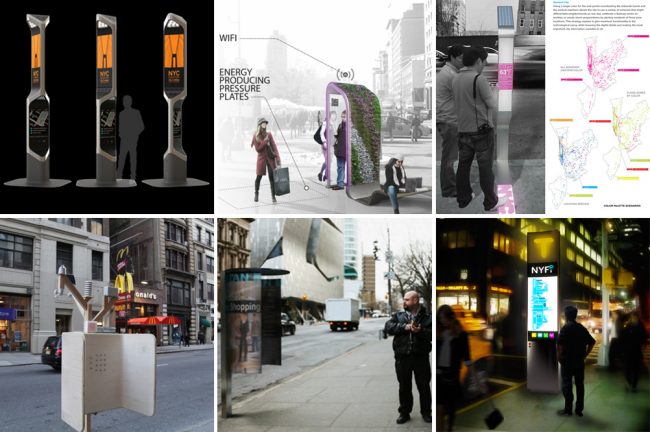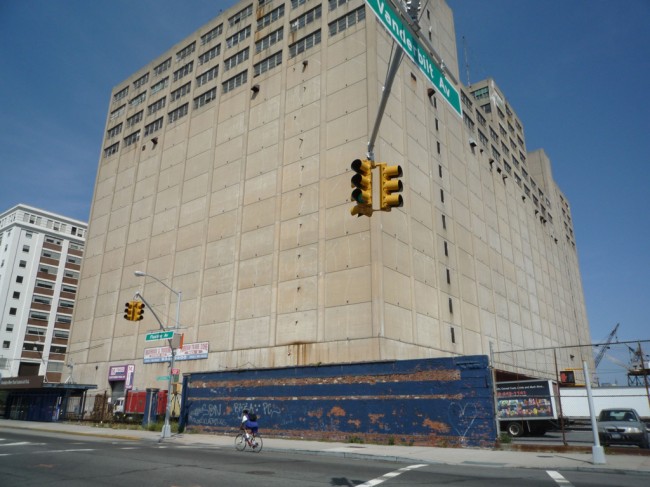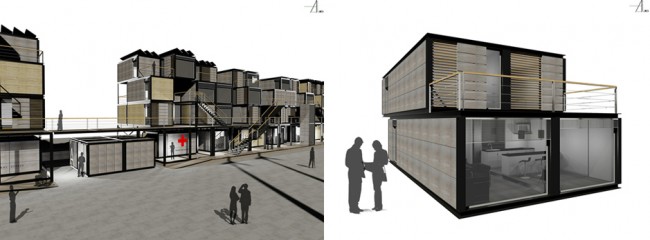
Celebrate ten years of Urban Omnibus and support ten more years of fresh, independent perspectives on citymaking with a donation today!
Celebrate ten years of Urban Omnibus and support ten more years of fresh, independent perspectives on citymaking with a donation today!

Reinvent Payphones finalists, clockwise from top left: Beacon, NYC Loop, Smart Sidewalks, NYFi, NYC I/O: Responsive City, Windchimes | Images via NYC Mayor’s Office
REINVENT THE PAYPHONE
On Tuesday, the Reinvent Payphones Design Challenge held its Demo Day, showcasing 11 semi-finalists from the pool of over 100 submissions and announcing six winners in the categories of Connectivity, Creativity, Visual Design, Community Impact, and Functionality. Apart from one design focusing solely on the form as a structure for gathering environmental data, the winning designs shared common elements of communication, providing access to local information such as transportation services, community board updates, advertisements for local businesses, evacuation and shelter announcements in the case of emergencies, and, of course, advertising revenue generation for the City. The interactive and adaptable nature of the designs also allow for additional uses as the city, or the present situation, changes. The Popular Choice Award will be announced on March 15th following public voting — cast your vote here.
HUNTER’S POINT SOUTH
Hunter’s Point South broke ground Monday in Long Island City. The project, New York’s largest residential development since Co-op City, will eventually include over 5,000 residential units, 11 acres of parkland, retail and community spaces, and a school that is already nearing completion. It continues the Bloomberg administration’s push to employ private developers in expanding the city’s affordable housing stock. 60% of the units will be set aside for middle-income families, including all 925 units in the two buildings starting construction in the first phase of the project. The project reaffirms the City’s commitment to development along the waterfront, despite calls to reassess these policies following the widespread flooding caused by Hurricane Sandy.
SAVING A PUBLIC MARKET
Last summer, we spoke with New Amsterdam Market founder Robert LaValva about his efforts to preserve the old Fulton Fish Market and create a new market there after vendors moved to the Bronx in 2005. Now, a petition is taking shape to fight plans to redevelop the South Street Seaport and surrounding areas. With the support of ten celebrity chefs, Save our Seaport and New Amsterdam Market are fighting to rezone the area to preserve the historic market and transform it into a food bazaar suited for both chefs and the public. They hope to gather 10,000 signatures before the end of the month.

Building 77, a former ammunitions depot, is the next Brooklyn Navy Yard building up for renovation. | Image via Emma Maria
NAVY YARD RENOVATION
The Brooklyn Navy Yard has announced its largest project to date: the $60 million renovation of Building 77, the last large building available to be redeveloped at the former shipyard. The 16-story, one million-square-foot building was formerly an ammunition depot. It has sat mostly vacant for the past 50 years and lacks windows below the top floors, but has potential to attract clients from New York’s growing tech sector, with possible sweeping views of Manhattan, Williamsburg and Downtown Brooklyn. This latest project adds to the list of increasingly large and frequent buildings coming online and finding new tenants in the manufacturing, tech, and creative sectors at the Navy Yard. The nonprofit Brooklyn Navy Yard Development Corporation is planning on redeveloping 1.8 million square feet over the next few years and hopes to attract new construction on an additional 20 underdeveloped acres in the future.
MANHATTAN: COMMUTER CENTRAL
It’s official: Manhattan is a big draw. According to the Census Bureau’s American Community Survey, the borough brings in more commuters than any other county in the country. In addition, nearly 400,000 people commute from New Jersey to New York, the largest number of workers travelling between any two states in the US.
SANDY UPDATES
Reports released this week by the Furman Center for Real Estate and Urban Policy at New York University and Enterprise Community Partners, an affordable housing developer, provided the first independent analyses of the impact of Hurricane Sandy on housing in the city. Both reports highlight the socioeconomic reality of the storm: of the 150,000 families who have applied for FEMA housing aid, 56% were renters, 61% make less than $60,000, and 31% make less than $15,000, verifying that the storm hit low-income residents hardest. The reports also highlight the number of at-risk buildings filled by mostly low-income residents, and note that much of the city’s elderly population is concentrated in flood-prone areas. At least 10,500 owners whose properties lie in such at-risk areas, as defined by FEMA’s new advisory flood zones, have been approved for $766 million in Small Business Administration (SBA) disaster loans, according to a WNYC and ProPublica analysis of federal data. While the SBA states that they are fulfilling their mission to aid homeowners and businesses recover and do not have a responsibility to take into account the revised flood maps, advocates worry that taxpayer funds are funding properties that will only be substantially damaged once again in the next storm.
The region’s transit systems took a hit this week as the U.S. Department of Transportation announced they would cut $545 million in aid to the region’s transportation infrastructure as a result of the sequestration. While money marked for returning the infrastructure to its pre-Sandy state remains intact, the funds headed toward hardening the system to protect it from future disasters will no longer be disbursed.

A prototype of post-disaster housing constructed from shipping containers | Image via NYC Office of Emergency Management
The City’s Office of Emergency Management is preparating for the next disaster to befall New York with the installation of a prototype for a post-disaster housing complex made of shipping containers in Downtown Brooklyn this summer. The prototype, which will be occupied by residents for at least six months, demonstrates a urban-specific approach to post disaster housing, as the containers can be stacked and clustered to resemble neighborhoods and installed quickly within disaster-affected areas.
Inland from the storm’s coastal devastation, waves caused by Sandy churned up the waters of New York City’s drinking water reservoirs, causing a drop in water quality that violated federal standards. The New York World reports that the system’s violation was the third of only five allowed in a ten-year period before federal authorities would require the installation of a filtration plant that could cost up to $10 billion.
EVENTS AND STUFF TO DO
STREET
Street, a new exhibit arranged around a film of the same name by James Nares, celebrates the spirit of the urban street and street life through May 27th at the Metropolitan Museum of Art. The film captures footage of Manhattan streets over a week in 2011 with a high speed camera, the kind used for filming hummingbirds or speeding bullets. The shots were then dramatically slowed such that the 61-minute film if shown in real time would amount to only three minutes. Met director Thomas Campbell said the film “makes accessible the countless individual moments, gestures, and interactions that are normally too fleeting to take in all at once.” The exhibit also includes 77 pieces selected by Nares from the Met’s collection as historic contextualization for the piece.
ONE PRIZE: STORMPROOF
Terreform ONE has announced its 4th annual ONE Prize Competition: STORMPROOF. Set within the context of severe climate dynamism, the open international competition addresses the need to build resilient cities, by calling for sophisticated designs that will reinvigorate infrastructure and repurpose spaces to “put design in the service of the community.” ONE Prize invites architects, urban designers, engineers, artists, students, and individuals of all backgrounds to submit.
A CREATIVE MORNING ABOUT RECYCLING
CreativeMornings, a monthly breakfast lecture series for creative types, will host Ron Gonen, New York City’s “Recycling Czar,” on Friday, March 15th, from 8:30am to 10:00am for a lecture and group discussion exploring the theme of “Reuse.” In addition to his work implementing the city’s solid waste program as Deputy Commissioner of Sanitation, Gonen is the founder of RecycleBank, a company that awards points to consumers for recycling that can be redeemed at local businesses. Free tickets can be reserved here beginning at 11:00am on Monday the 11th.
MOMA PS1 ROCKAWAY CALL FOR IDEAS
MoMA PS1, in its ongoing effort to foster creative debate in the aftermath of Hurricane Sandy, has issued a call to submit short videos of ideas to create a sustainable waterfront, including alternative housing models, creation of social spaces, urban interventions, new uses of public space, the rebuilding of the boardwalk, protection of the shoreline, and actions to engage local communities. 25 proposals will be presented in PS1′s temporary relief and cultural VW Dome 2 in the Rockaways throughout April 2013.
OPEN CITY FELLOWSHIP
Applications are open for the Creative Nonfiction Fellowship with Open City, an online magazine documenting “the pulse of metropolitan Asian America as it’s being lived on the streets of New York right now.” Five fellows will receive $5,000, career guidance, and publishing opportunities for short- and long-form editorial content on immigrant communities in Manhattan, Brooklyn, and Queens. The fellowship is operated in partnership between the Asian American Writers’ Workshop, the New Museum, and the Museum of Chinese in America. View their call for applications for more information and how to apply, and look back at this 2011 UO feature to learn more about the Open City project.
HENRI LABROUSTE AT MoMA
From March 10th through June 24th, the Museum of Modern Art (MoMA) will showcase the work of 19th century architect Henri Labrouste, known for his impact on the use of space, materials and luminosity in places of great public assembly. His two best known projects, the monumental reading rooms of the National Library and the Saint-Genevieve Library in Paris, helped shape the idea of the library as “a temple of knowledge and as a space for contemplation.” The exhibit includes original drawings, photographs, films, and models to illuminate Labrouste’s contributions.
The Roundup keeps you up to date with topics we’ve featured and other things we think are worth knowing about.
The views expressed here are those of the authors only and do not reflect the position of The Architectural League of New York.